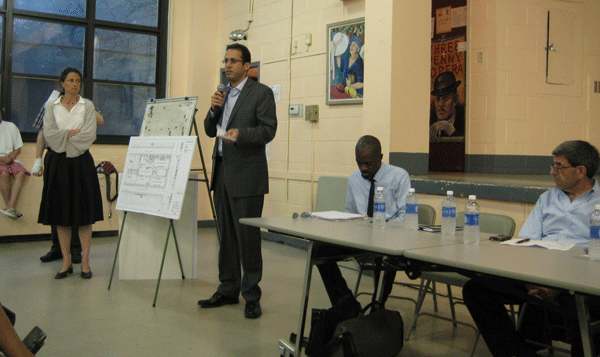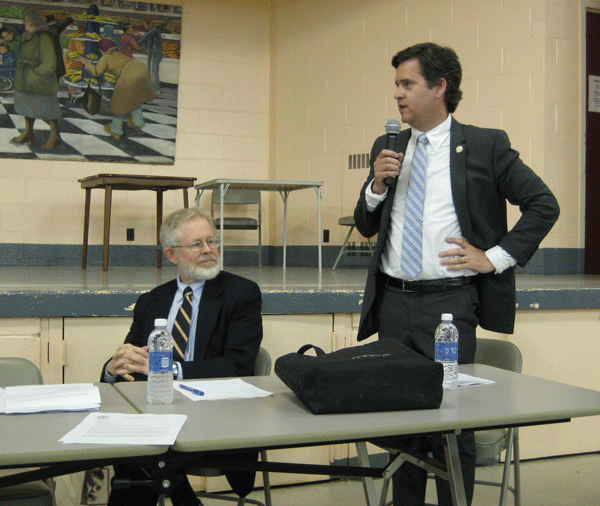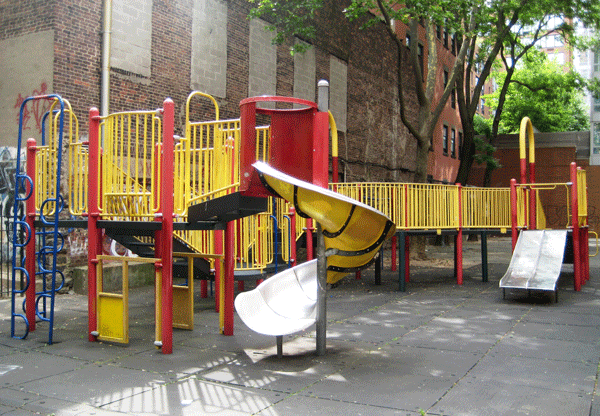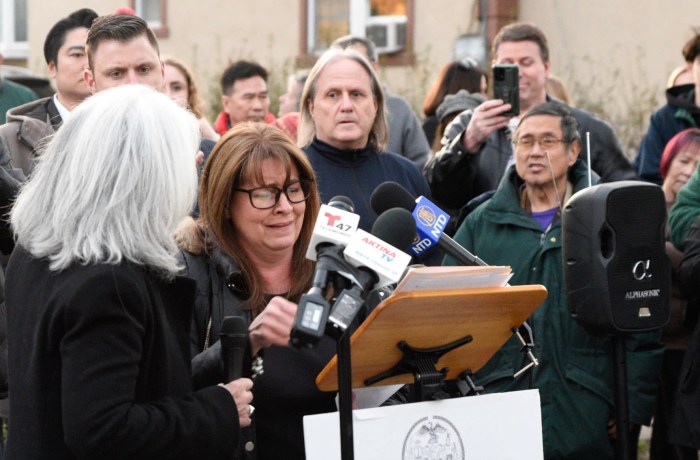
BY EILEEN STUKANE | Young, old, able-bodied and disabled, the residents of West Chelsea’s Fulton Houses presented a united front, ready to face down the developers who came to the Fulton Houses’ Community Center on the evening of Wednesday, July 10 to present their plans to the community. The residents had received prior word that Artimus Construction, along with the NYC Department of Housing Preservation & Development (HPD) and the NYC Housing Authority (NYCHA) had changed the agreed-upon plans for construction of affordable housing on the north side of West 18th Street near 10th Avenue, and they did not like what they had learned.
Originally, plans called for a building of 100 units of affordable housing, with underground parking. The revised plans were for 158 units without underground parking, but with outdoor lots. New parking lots were going to be built, on space that would be made by demolishing a large children’s playground of sprinklers, slides and climbing equipment, as well as a flower garden and a vegetable garden on the north side of West 17th Street and a smaller playground on the south side of West 17th Street. This, in a part of the city, which according to Matt Weiss of Friends of 20th Street Park, is “last out of 12 districts in Manhattan when it comes to number of parks” and has not seen a new playground built “in over 45 years.”
The simmering anger of the approximately 150 people in the room was palpable as they looked upon a panel that included Gbenga Dawodu, representing NYCHA, Robert Ezrapour of Artimus Construction, Beatriz de la Torre, assistant commissioner of planning for HPD, Richard Gottfried, NY State Assemblymember and Brad Hoylman, NY State Senator.

Squinting won’t help: Artimus Construction’s poorly received presentation lacked handouts, projections.
POSTER BOARD PRESENTATION LACKS POWER TO MAKE POINT
Torre of HPD started by saying that the West 17th Street playground would not be displaced and that they (the project managers) were meeting with the community as part of the Uniform Land Use Review Procedure (ULURP) process to get feedback from the people. She was unclear about which playground she was referring to, an issue that despite further questioning was not clarified or resolved to the satisfaction of those in attendance. At the end of the meeting Torre again said that the West 17th Street playground would not be touched — but the lack of clarity had everyone confused.
Representatives of Artimus and their architects, Gerner Kronick & Valcarcel, attempted to present poster board renditions of architectural drawings to the audience, but these were impossible to see. Shouts rang out: “Don’t you have this material in handouts?,” “Where are the handouts?” and “Why are there no screen projections, PowerPoint presentations?”

Roberto Rodriguez, a member of the audience, stood to say, “I’m surprised that you would have such a complicated diagram that makes it hard for us to envision anything at all. That’s a lack of respect for these people. What I should be hearing from you if you were honest and respectful of anybody here in this audience is ‘I’m sorry that we didn’t make this a little better presentation.’ This is unprofessional as far as I’m concerned.” Applause echoed within the walls. The developers’ presentation was going nowhere.

July 10’s presentation left many wondering which of the two playgrounds in question would become a parking lot, if current plans for affordable housing are approved.
Especially irritating to the residents was the fact that without any notice to the community or elected officials, the construction project, with its changes, had received a ULURP certification from the Department of City Planning (DCP) on Monday, July 8 — just two days before the meeting was called. This meant that Community Board 4 (CB4) was on the clock, and within 60 days had to hold public hearings and make any recommendations for changes to the City Planning Commission (CPC), or lose the right to be effective. After CB4 weighs in, the borough president has 30 days to respond, and the CPC, 60 days after that — at which point it goes before the City Council for a final vote (subject only to mayoral override, which is rarely invoked)
Clearly, the early planning stages of the project has passed. CB4, the borough president, CPC — all are now on deadline, during a summertime period when many residents are away, and not around to attend CB4 meetings for comment.
Miguel Acevedo, president of the Fulton Tenants Association, moderated the evening and gave the floor Assemblymember Gottfried, who spoke with conviction. “I think a developer who comes before a community with such an outrageous proposal, that was proposed in such an outrageous way, where you go back on what was promised and instead propose without any prior notification, you go straight to ULURP so the clock starts running,” Gottfried paused, “the idea that a developer like that would be tolerated in this community is unacceptable.” After loud applause, Gottfried went on to say that he felt that the demolition of the playgrounds was typical developer behavior — create an issue that takes center stage, ultimately elicits a compromise, and deflects focus from other aspects of the construction.
“At least to show some thread of good faith, the certification should be withdrawn,” said Gottfried, and added, “apologies to the community for the way you have treated us and the total disrespect with which you have treated us, and I think it may be time to think about finding a new developer for this project.”
Hoylman reaffirmed Gottfried’s stand, “You should stop the clock immediately, get your act together, come back and treat us with some respect.” He also felt that because this was a NYCHA project, the developer was not using the same standards that he would for a private development deal. Letters from CB4 and City Council Speaker Christine Quinn to Matthew Wambua, Commissioner at HPD, also expressed outrage over the plans. Speaker Quinn wrote, “I want to be clear — I do not, and will not support a development plan that displaces a playground to make up for lost parking.” Yetta Kurland and Corey Johnson, candidates for Quinn’s District 3 City Council seat, also spoke in solidarity with the community. Johnson, as chair of CB4, pledged the community board’s support.
SITE’S AFFORDABLE HOUSING OUT OF REACH FOR FULTON RESIDENTS
Years ago, CB4 had been in on the negotiations for affordable housing construction in Chelsea. The building is only being undertaken as a result of the city’s commitment to the community for the 2005 rezoning of West Chelsea and Hudson Yards. The city promised that in return for the rezoning and the influx of new luxury housing, 100 units of affordable housing for moderate-to-middle income families would be built on West 18th Street (between Ninth and 10th Avenues) on a parking lot on Fulton Houses, property owned by NYCHA. Artimus Construction was chosen as the developer in 2007 in this public/private partnership with NYCHA and HPD. This project has been in process for years — and in that time, what is considered “affordable” has changed along with the plans.
While salaries of incoming policemen and firefighters have recently dropped to the range of $25,000 to $30,000, the 2013 Area Median Income (AMI) for New York City, as calculated by the Department of Housing and Urban Development (HUD), is $85,900. Moans and groans rose up from the community as the availability of apartments in this moderate-to-middle income “affordable” rental housing was outlined by Torre. The mixed income development of the proposed 158 apartments would have 20 percent of the units available at 50 percent of AMI, which is based on income between $30,100 for a one-person household to $42,900 for a four-person household; 20 percent at 80 percent of AMI, or income between $48,100 for a one-person household to $68,700 for a four-person household and 20 percent at 130 percent of AMI, or income between $78,000 for a one-person household to $110,000 for a four-person household. The remaining 40 percent at 160 percent of AMI, or income between $98,000 for a one-person household to $140,000 for a four-person household.
Torre also said that 20 percent of the apartments would be designated for NYCHA, but since she had already accounted for 100 percent of the apartments, the NYCHA availability was unclear. The project is designed to bring in what is being called “moderate-to-middle class” dwellers based on the AMI. There are no “low income” apartments factored in.
The Fulton Houses residents, many getting by on social security checks, did not relate to the “affordability” of the housing that was to emerge in their midst. There was sardonic laughter and remarks made aloud about how the affordable bodegas are gone, the affordable Associated supermarket. The mom-and-pop stores that used to make life in the Fulton Houses easier were gone due to stratospheric rent increases, and replaced by those businesses that could afford to pay — upscale fashion designers like Stella McCartney and Alexander McQueen (who have ironically fled the Meatpacking District as big name chains such as Patagonia have arrived). “There’s more than one way to push us out,” cried a voice in the crowd.
WHY WAS UNDERGROUND PARKING PLAN ABANDONED?
Martin, a resident who only wanted to be identified by his first name, asked the reason why the original plan which included underground parking was changed. Torre replied that the original plan was “financially unfeasible” and asked the developer to elaborate.
Robert Ezrapour of Artimus explained, “In our original proposal we suggested 112 parking spaces to make it economically viable. We were told that CB4 would not be receptive to any additional parking spaces. The original proposal was 104 apartments. We made it 158 apartments but with underground parking, it did not make economic sense.” Then he digressed, “Nothing is going to be built until we go through the process, the ULURP process. It’s unfortunate that the ULURP is certified. I think in the history of the agency, a ULURP has never been certified in six weeks, and that’s because there’s pressure. Sorry folks, but in an election year there’s pressure that doesn’t normally come into play. We’re going to come back, give you more details, and rest assured, nothing will get built until you get a good flavor.”
Gottfried asked “What pressure are you talking about?” but his question went unanswered, leaving room for speculation. Among the residents gathered, several wondered whether political pressure was being asserted by an outgoing administration or by those who hoped to be elected.
Martin then asked whether the developer would consider removing the certification. “Pull the ULURP. Stop the clock,” said a resident named Rosario. Torre answered with, “I know that this is not what you want to hear, but I cannot say that right now.”
Gottfried took the microphone and said, “To the developer, I don’t know that you listened to the question from the gentleman here. He was very careful. He didn’t ask if you would withdraw the certification, he asked if you would consider it and I can’t imagine why you wouldn’t immediately say, ‘We will give you the decency and respect of promising that we will consider that.’”
Ezrapour responded with, “HPD and NYCHA are the applicants. In the ULURP process you have many opportunities to voice your concerns. This application has to go through several approval processes. This is just a start.”
Acevedo put the question of withdrawing certification to Gbenga Dawodu of NYCHA who responded with “I’m not in a position to answer that right now…We are open to all the input you guys gave us and we can go back to the drawing table and present modifications that we discussed today.”
Fulton resident Irene O’Connell voiced what others were probably thinking. “What is interesting is that no one is in a position to do anything. This is great, tell us what is going to happen but don’t give us anything that’s concrete because ‘We can’t say.’ You knew about this before you came today and it was okay.”
The meeting drew to a close with Acevedo assuring the community that the Fulton Tenants Association was now working with a lawyer. Assemblymember Richard Gottfried forcefully reiterated his belief that the ULURP certification should be withdrawn, and speaking to the developers said, “I think you need go back to square one with this community. Come to us and say, ‘Here’s what we’re thinking of proposing, what do you think about it,’ not with a clock running. Then develop a proposal that you can submit to ULURP. Until you withdraw the proposal from ULURP you’re going to have an awful lot of angry people here.”
NOTE: The day after the meeting, on July 11th, Gottfried wrote a letter to Matthew Wambua, Commissioner of HPD. The letter begins: “The Department of Housing Preservation and Development (HPD) should immediately withdraw its plan to build housing on the grounds of the NYCHA Fulton Houses development and remove a playground and community garden and replace them with a parking lot, certified with the City Planning Commission earlier this week.” The letter goes on to refer to the events at the meeting.

















